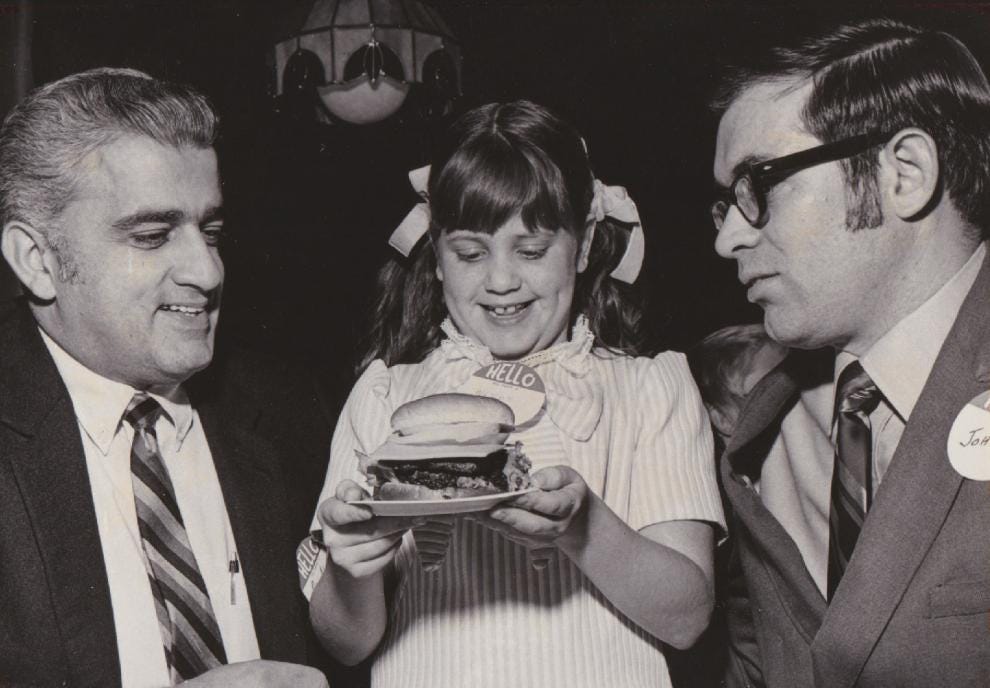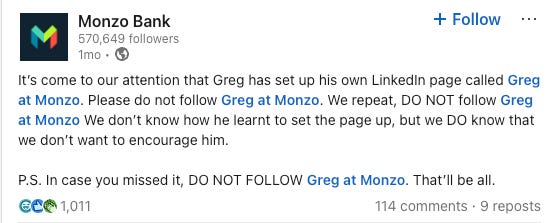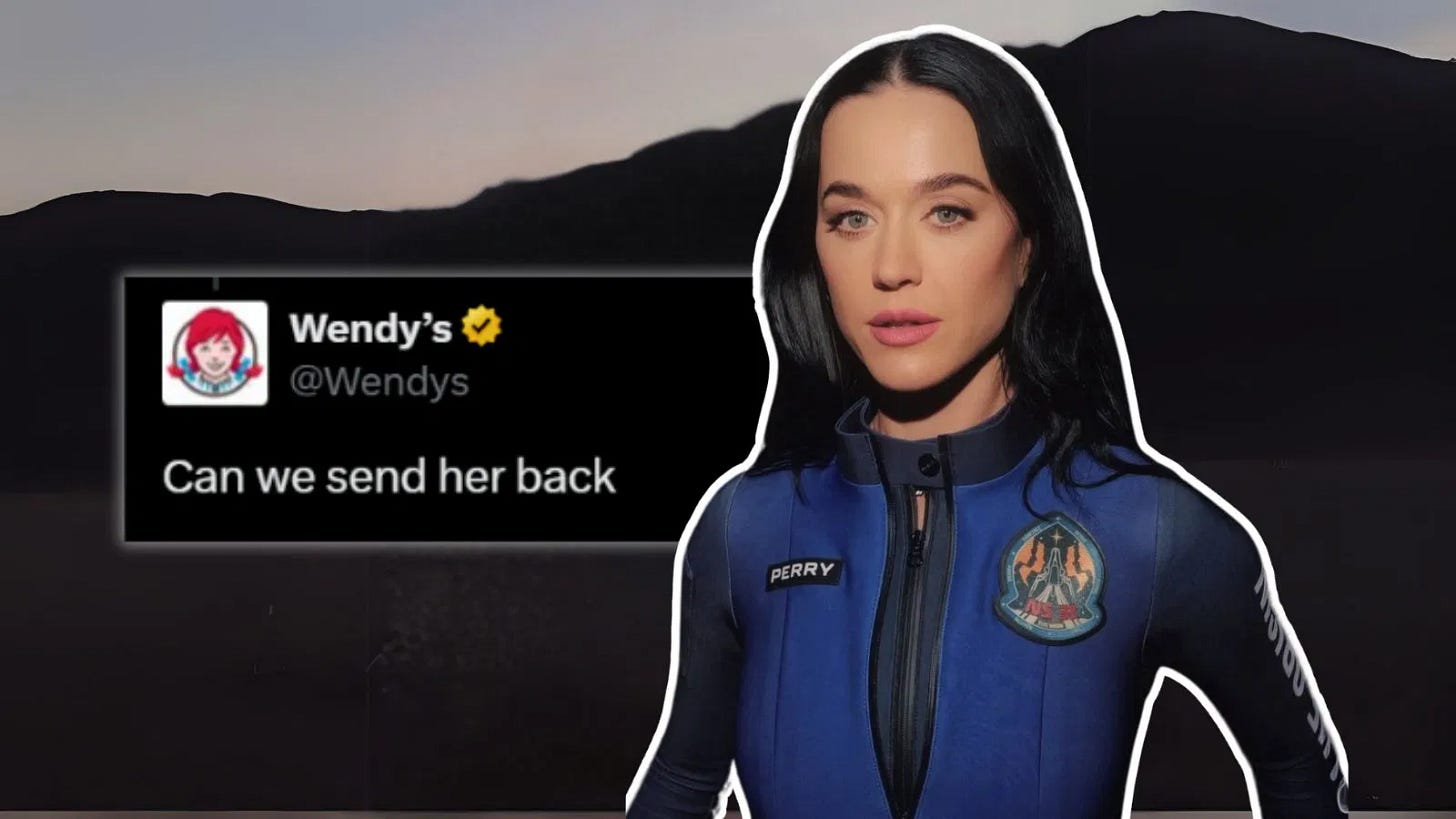The Personification of Social Media
When brands talk like people, shouldn’t they be held to the same standards?
On my last Substack, I promised a deep dive into content operations—how brands are using Gen AI to work smarter, faster, and with integrity.
That piece is still cooking (shoutout to the 11 of you waiting patiently—two of whom are reading this in my group chat).
But if there’s ever a time to follow the curiosity, it’s on your own Substack. And lately, I’ve been thinking about something else:
How brands have started acting like people—and what happens when we start expecting them to behave like people, too
Over Easter, somewhere between brisk Norfolk walks and roast potatoes, I found myself explaining the Katy Perry vs. Wendy’s internet drama to my mum. Mid-rant, I paused.
“Wait… why is a fast food brand subtweeting a woman in STEM?”
When a Burger Brand Becomes a Moral Commentator
Let’s rewind. Katy Perry recently completed a spaceflight with Blue Origin—the Jeff Bezos-owned rocket tourism company—joining an all-female crew that included Lauren Sánchez, Gayle King, Aisha Bowe, Amanda Nguyen, and Kerianne Flynn.
I’m not here to dissect the cultural weight of that mission; though I recommend this piece by the Contrarian and this one by the Guardian for excellent perspective. Instead, I want to zoom in on what happened next and what it reveals about brand voices on social media.
Wendy’s, the fast-food chain known for square burgers and even sharper tweets, responded to a post announcing Katy Perry’s return to Earth after the 11-minute flight with the now-notorious line: “Can we send her back?”

The internet split in two.
Some found it hilarious and they congratulated Wendy’s for using their unhinged TOV to immerse themselves into the conversation. Others (including Perry herself) were hurt. Critics pointed out that a billion-dollar brand was using its platform to publicly undermine a woman’s accomplishment.
One source close to the mission told People Magazine, “This was a billion-dollar brand using its platform to publicly demean a woman.” The backlash prompted Wendy’s to follow up with a now-infamous statement: “We respect Katy and the out-of-this-world talent she brings to everything she does.” It stopped short of any real apology. That refusal to acknowledge harm only fuelled the criticism further.
The irony wasn’t lost on anyone: a brand whose logo is literally a woman — based on founder Dave Thomas’s daughter — took aim at another woman making history. It added an uncomfortable layer to the fallout and called into question how well brands truly understand the weight of their voice.

The incident underscored the risks of brand personification — when a company adopts a human voice, it also inherits the responsibilities that come with it. In the rush to be entertaining, relevant, and algorithm-friendly, it’s easy to forget the weight that words carry — especially when directed at individuals. As Cindy Kerber Spellman aptly put it:
“Digital responsibility is on all of us. And so is integrity.
If you want to joke like a person, you also need to be accountable like one.
Yes, brands can be cheeky. They can be bold. But they also need to know when they’ve gone too far — and more importantly, who they’re speaking to. Especially in this current climate, and especially when humour comes at the cost of a woman making space for herself — quite literally.
Ryanair’s Social Media Strategy: Where Wit Meets the Wall
If there’s a brand that’s mastered the art of walking the fine line between irreverent and inappropriate (most of the time), it’s Ryanair. Under the creative direction of Michael Corcoran, the airline’s social media presence evolved into a case study in bold, platform-native content — unapologetically cheeky, ruthlessly self-aware, and often wildly viral.
At the time of writing, their TikTok account boasts over 2.6 million followers and 53.4 million likes. Their strategy? Embrace the brand’s budget reputation, meme it before anyone else does, and use humour to turn flying frustrations into shared cultural moments. The result was a social voice that resonated — particularly with younger audiences who value honesty over polish.
 Tiktok failed to load.
Tiktok failed to load.Enable 3rd party cookies or use another browser
Corcoran has openly shared the mechanics of this approach: the team followed internet culture closely, played with formats native to each platform, and kept the tone agile. But even the most seasoned brand voices can find themselves on shaky ground.
Earlier this year, Ryanair posted a meme on X (formerly Twitter) that appeared to mock a passenger’s baldness. While some laughed, others—including marketing expert Andrew Tindall & Hristina Tsolova called it out for crossing a personal line. The backlash quickly turned into a wider conversation: how far is too far when brands act like people?
What made the moment notable was Corcoran’s response. Though no longer at Ryanair, he took to LinkedIn with a clear, thoughtful reflection. He acknowledged the brand’s proximity to the edge — but drew a firm line between playfulness and personal attacks. During his tenure, he explained, the team was clear: no jokes about appearance, identity, or anything that punches down.
“I’d layer with today’s social & how extreme it is - that the comedy effect of what we were doing is fading as the extreme online haters love the roast/clapback and they are eating this up, hating more and can get more dangerous.”
Corcoran’s response didn’t just explain the strategy — it showed what responsible social leadership looks like. Behind every viral joke is a team making real decisions with real consequences. The goal, as Corcoran put it, was always to centre humour around the flying experience — not individuals.
And that’s the nuance more brands could learn from: wit is powerful, but respect is what sustains longevity.
A Brand That’s Doing It Right: Monzo Bank
Monzo Bank has become the poster child for how personality can exist in regulated industries like finance. Led by Social Media Lead Richard Cook, Monzo’s voice is witty, charming, and refreshingly human.
Their standout move? Enter 'Greg at Monzo'—a fictional employee with his own LinkedIn presence. Greg shares inside jokes, office anecdotes, and subtle nods at corporate life, all with a tone that’s absurd, timely, and unmistakably Monzo. Greg lives in the Monzo universe to build connection, not push product.

This is what happens when a brand truly understands platform culture. Instead of fighting LinkedIn’s weirder side, Monzo leaned in — hard. They saw what people actually want to engage with (humour, relatability, chaos), and met them there. The result? A finance brand people want to follow. Imagine that.
By putting the audience first — not the product — Monzo has carved out a tone that feels conversational, creative, and refreshingly unbank-like. It’s helped speed up content production (less stakeholder fuss, more audience-first thinking), and it’s won them genuine engagement, not just vanity likes.
In a sea of safe B2B comms, Monzo dares to be…a little bit weird. And it works. Because the best brand personalities don’t mimic people — they behave like people. They tell jokes. They break the fourth wall. They make you feel like someone’s actually behind the screen.
Where’s the Line?
The more human a brand becomes, the more it’s held to human standards. And unlike real people, brands don’t get the benefit of the doubt.
Is it when Wendy’s jokes about a woman’s career milestone? Is it when Ryanair pokes fun at baldness? Is it when Oatly posts something so self-aware that it forgets to sell the product?
The truth is, the line keeps moving. But maybe that’s the point.
Closing Thoughts: When Brands Talk Like People, They’re Judged Like People
I love that brands are showing up with more personality. I love that we’re past the era of sterile product shots and curated flatlays. But brand personification isn’t just a strategy — it’s a responsibility.
When companies start speaking the language of the internet, borrowing from human behaviour, humour, and identity, they inherit some of the same expectations. And that comes with a higher bar. Because once a brand starts acting like a person, we’ll expect it to know better — and do better.
So before your brand claps back or jumps on a trend, ask: is this a moment? Or a misstep?
Let’s keep our brand voices bold — but let’s also keep them grounded.
And yes, that content ops deep dive is still coming. Probably.
Venice 💛
If this sparked something, share it with someone who’s been thinking deeply about brand voice, tone, or where the line really is.
Someone in your orbit might need to hear it too.
Sharing is caring — and keeps the real ones writing.
Want more like this?






I must admit when I saw the Wendy’s tweet I chuckled a bit